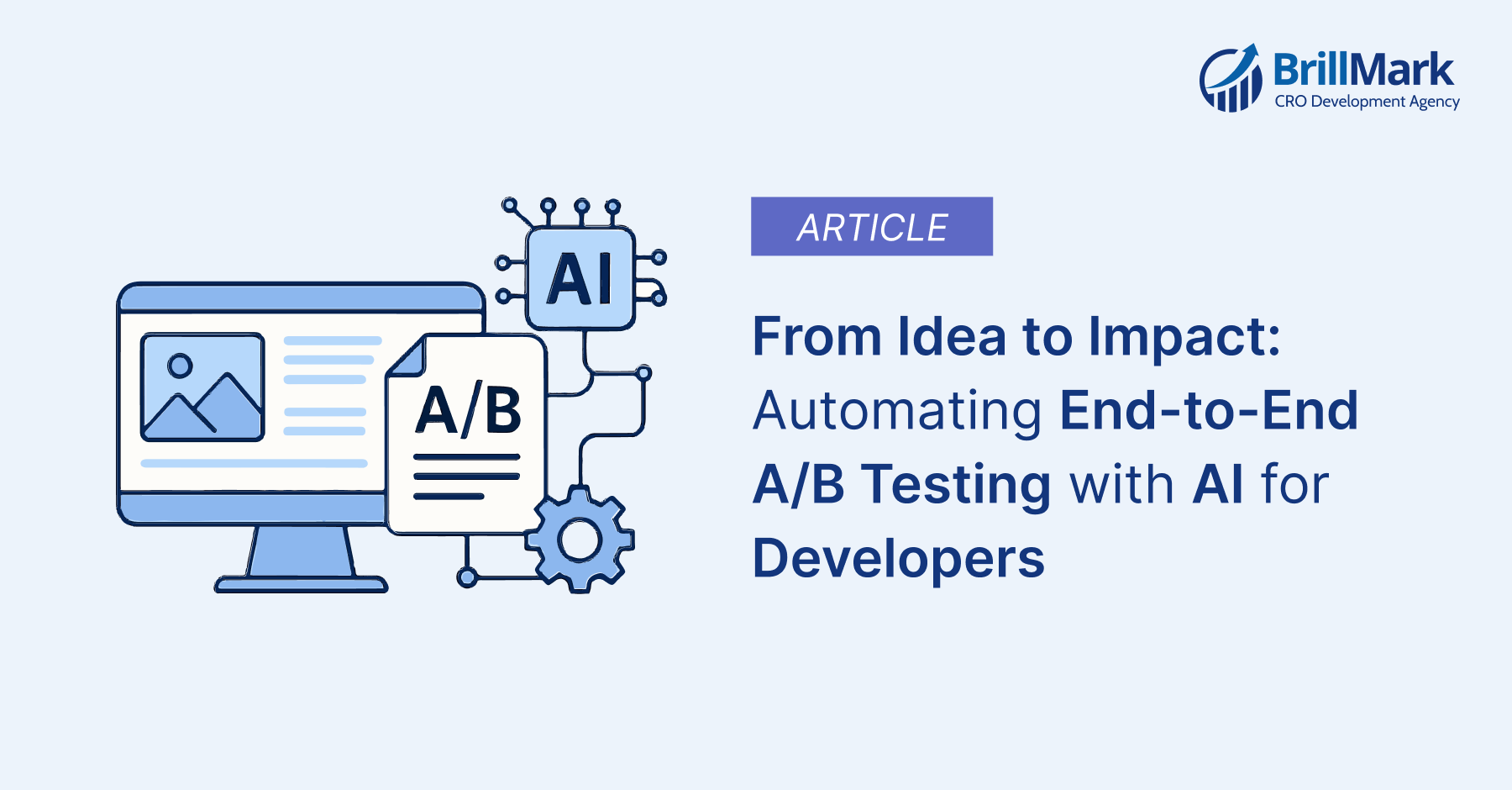A/B testing, the practice of comparing two versions of a webpage, app feature, or marketing asset to see which performs better, has long been the bedrock of improving user experiences and driving conversion rate optimization (CRO).
Yet, the traditional A/B testing process—manual hypothesis generation, cumbersome test setup, static traffic allocation, and time-consuming analysis—can be slow, limited in scale, and a significant bottleneck to rapid iteration and innovation.
The advent of Artificial Intelligence and automation is fundamentally transforming this landscape. Organizations can achieve unprecedented speed, scale, and precision by strategically applying AI and Machine Learning across the entire experimentation lifecycle, from initial test ideation to final deployment and analysis. This end-to-end automation is particularly relevant for AI-oriented clients seeking to maximize the value of their data assets and for developers tasked with building or integrating the sophisticated testing frameworks of the future.
This article delves into how AI enables the automation of every stage of the A/B testing process, highlighting the pivotal role of AI, the benefits for AI clients, and the technical considerations for developers building these powerful systems.
The Automated A/B Testing Lifecycle: AI at Every Stage
AI doesn’t just enhance A/B testing; it revolutionizes it by automating and optimizing each phase, creating a dynamic, self-improving system.
1. Automated Ideation & Hypothesis Generation: From Guesswork to Data-Driven Ideas
The starting point of any A/B test is an idea or hypothesis about what change might lead to a better outcome. Traditionally, this relies heavily on human intuition, manual analysis of user feedback, and reviewing basic analytics reports, which can be inefficient and prone to bias.
AI’s Transformation: AI-powered CRO tools and advanced analytics platforms continuously analyze vast, complex datasets that would be impossible for humans to process manually. This includes granular user behavior, clickstream data, conversion funnel performance, heatmaps, session recordings, and even unstructured data like customer support interactions and chat logs from platforms like Live Commerce. AI algorithms excel at detecting subtle patterns, identifying user segments experiencing friction, and pinpointing specific pages or flows with significant drop-off rates (Kameleoon, HubSpot).
Based on these data-backed observations, AI can automatically formulate specific, testable hypotheses. These hypotheses are directly grounded in actual user behavior, significantly increasing the likelihood of a positive test outcome. Furthermore, Generative AI can assist by suggesting multiple variations for headlines, body copy, calls-to-action, or even basic layout structures, tailored to the identified issue and target user segment (Kameleoon, Looppanel).
- Example: An AI system analyzing user journeys on an e-commerce site might detect that users who view a specific category of products frequently click on a “Compare” button but rarely proceed to a comparison page. The AI could hypothesize that the button is unclear or the comparison feature is hard to find, and suggest testing variations of the button text or placement, automatically generating options like “Compare Products,” “Add to Comparison List,” or an icon-based alternative.
This stage transforms A/B testing from a reactive process into a proactive, data-led engine for continuous improvement, generating a backlog of high-potential test ideas automatically.
2. Automated Experiment Design: Setting Up Tests Smarter and Faster
Designing a statistically sound A/B test involves defining variations, selecting appropriate metrics, determining the required sample size, calculating test duration, and segmenting the audience. Manual execution of these steps can be time-consuming and requires statistical expertise.
AI’s Transformation: AI-powered A/B testing platforms automate key design decisions, making test setup faster and more accurate (Functionize). Based on the test hypothesis, the target audience, and the desired impact, AI can automatically:
- Select the most relevant primary and secondary metrics to track for the experiment.
- Calculate the required sample size and estimate the test duration needed to reach statistical significance, eliminating manual statistical guesswork and ensuring reliable results.
- Precisely define and configure the target user segments for the test based on complex behavioral or demographic criteria, ensuring the test is run on the most relevant audience.
- Suggest the optimal traffic allocation strategy for the experiment (e.g., a standard 50/50 split or a dynamic approach).
- Example: For a test aimed at increasing newsletter sign-ups on a blog page, the AI would automatically set “Newsletter Sign-up Completion” as the primary conversion metric, calculate the required traffic volume and estimated run time based on the page’s typical traffic and expected lift, and configure the test to target first-time visitors.
Automated design ensures tests are statistically sound, efficiently configured, and targeted effectively, reducing setup time and the risk of human error.
3. Automated Variation Creation (Assisted) & Implementation: Building and Deploying Efficiently
Creating the actual test variations and deploying them to a live environment has traditionally been a developer-heavy task, often requiring manual coding and coordination with release cycles. While full automation of complex UI changes is still evolving, significant assistance and streamlined deployment are now possible.
Automation and AI Assistance:
- Low-Code/No-Code Editors: Many A/B testing platforms offer visual editors that empower marketing or product teams to make simple text, image, or styling changes to create variations without writing code (Functionize).
- Generative AI for Content: As mentioned earlier, Generative AI can quickly produce multiple options for text, images, or even simple UI elements for variations, significantly reducing the manual effort for content creation.
- AI-Powered Coding Assistants: For more complex changes that require custom code, AI coding assistants can help developers write the necessary code snippets or suggest implementation patterns, accelerating the development process.
- Automated Implementation & Deployment: Modern A/B testing platforms integrate directly with websites and apps, allowing variations to be deployed dynamically for specific users without requiring a full code release for every test. Using feature flags allows developers to build code for multiple variations simultaneously and then use the A/B testing platform or a separate feature flagging service to control which variation is shown to which user segment (Algolia, Monday.sys). Automated CI/CD pipelines ensure that once the code for variations is written and reviewed, it goes through automated testing and can be deployed to the testing environment efficiently.
- Example: A developer needs to create two variations of a product detail page layout. They use an AI coding assistant to quickly generate the basic HTML structure for both layouts. These layouts are implemented using feature flags. The A/B testing platform is then configured to use these feature flags to show either the original layout (control) or one of the new layouts (variations) to the target audience segment.
This stage benefits significantly from developer expertise in integrating tools and implementing robust deployment strategies that decouple experimentation from standard release cycles.
4. Automated Traffic Allocation: Optimizing Performance During the Test
Once a test is live, manually managing traffic splits and waiting for the predetermined test duration to end can mean lost opportunities, especially if one variation is clearly outperforming others.
AI’s Transformation: Instead of a static 50/50 split, AI-powered A/B testing platforms can use dynamic traffic allocation strategies, often powered by Machine Learning algorithms like Multi-Armed Bandits (Kameleoon, Gravity Field, Dynamic Yield). These algorithms automatically adjust traffic distribution in real-time, sending a progressively larger percentage of users to the better-performing variations as data is collected. This approach maximizes overall performance during the experiment, reducing the opportunity cost of showing underperforming variations. AI also ensures that traffic is allocated correctly within the specific user segments defined for the test.
- Example: In a test comparing two different checkout button colors, the AI starts by showing both colors equally. As data comes in, if the green button shows a significantly higher click-through rate, the AI automatically begins sending 70%, then 80%, and eventually a higher percentage of traffic to the green button variation, while still allocating a small percentage to the other variation to continue learning.
Dynamic allocation ensures tests run efficiently, minimize potential losses from underperforming variations, and adapt in real-time to user responses.
5. Automated Data Collection & Monitoring: Ensuring Accuracy and Reliability
Collecting accurate and complete data is fundamental to valid A/B testing. Manually ensuring all relevant events are tagged and tracked, and monitoring data quality during a live test, is prone to errors and can be overwhelming during high-traffic periods.
Automation and AI Solution: A foundational step is implementing a robust, automated event tracking system that reliably captures every relevant user interaction (clicks, views, form submissions, purchases, Live Commerce interactions) and links it to the correct user and test variation. AI plays a crucial role in data quality monitoring, continuously analyzing the incoming data stream for anomalies, inconsistencies, or missing information that might indicate a tracking error. AI can automatically trigger alerts to developers or analysts when potential data issues are detected, allowing for quick resolution before test results are compromised (FigPii).
- Example: During a test on a product page, the AI monitoring the tracking data might detect that “Add to Cart” events are firing correctly for the control group but are significantly underreported for the variation group, triggering an alert that there might be an implementation issue with the variation’s tracking code.
Automated data collection and AI-powered monitoring ensure the reliability and integrity of the data used for analysis, which is paramount for making confident, data-driven decisions.
6. Automated Analysis & Reporting: Faster Insights, Clearer Results
Analyzing A/B test results, especially when considering statistical significance, confidence intervals, and performance across multiple user segments, can be complex and time-consuming. AI automates the heavy lifting of statistical analysis and reporting.
AI’s Transformation: AI-powered A/B testing platforms automatically perform all necessary statistical calculations (p-values, confidence intervals, statistical significance) in real-time as data accumulates (Omniconvert, Looppanel, FigPii). AI automatically identifies the winning variation as soon as statistical significance is reached (or even earlier with Bayesian approaches), potentially stopping the test automatically to maximize gains. AI also automatically analyzes how each variation performed across different user segments, revealing nuanced insights that manual analysis might miss. Finally, AI generates automated, clear, and concise reports summarizing the test results, key metrics, statistical findings, and performance by segment (Kameleoon).
- Example: For a test on a homepage banner, the AI analyzes click-through rates. Once the data shows with 95% confidence that Variation B is performing better, the AI declares Variation B the winner, stops the test, and generates a report showing the percentage lift in click-through rate and how this varied across different traffic sources (e.g., paid search vs. organic).
Automated analysis provides faster, more reliable insights, allowing teams to make decisions quickly and move on to the next optimization opportunity.
7. Automated Decision Making & Iteration: Closing the Loop for Continuous Improvement
The final stage involves reviewing the results, deciding whether to implement the winning variation, and planning next steps or follow-up tests. Manually managing this process can slow down the overall optimization velocity.
Automation and AI Assistance: AI-powered A/B testing platforms provide clear recommendations based on the test results, statistical significance, and predicted long-term impact on key business metrics. For clear winners, the system can be configured to automatically roll out the winning variation to 100% of the target audience, immediately capitalizing on the positive result. Furthermore, AI can suggest or even automatically set up follow-up tests based on the learnings from the completed experiment (e.g., test further variations of the winning design, or test the winning design on a different audience segment). This enables a true continuous optimization loop, where insights automatically lead to action and further experimentation (Evolv AI, Omniconvert, Functionize).
- Example: After the homepage banner test, the AI recommends rolling out Variation B. The system automatically deploys Variation B to all users. The AI then suggests a follow-up test: since the banner performed particularly well for users from paid search, test different messaging on the banner specifically for that segment.
This stage closes the loop, turning insights into action and ensuring the optimization process is ongoing and increasingly sophisticated.
Benefits for AI-Oriented Clients
For organizations already invested in Artificial Intelligence and data-driven strategies, embracing end-to-end automated A/B testing offers significant advantages:
- Faster Time to Insight and Impact: Automation accelerates every stage, meaning you learn what works and implement changes much faster than with manual processes.
- Increased Experimentation Velocity: The ability to automate tasks allows teams to run a significantly higher volume of tests simultaneously, exploring more ideas and optimizing more parts of the user journey.
- More Precise Optimization: AI-powered analysis and segmentation enable highly targeted tests and personalized experiences, leading to more impactful results and higher conversion rates.
- Better ROI: By quickly identifying winning variations and dynamically allocating traffic, you maximize the gains from successful experiments and minimize exposure to underperforming ones, leading to a higher return on optimization efforts.
- Competitive Advantage: Rapid adaptation based on real-time data allows businesses to respond quickly to changing user behavior and market conditions, staying ahead of competitors.
- Maximizing Data Value: Leveraging AI for A/B testing provides a clear and direct way to translate complex user data into tangible business improvements.
These benefits align perfectly with the goals of AI-oriented clients seeking to leverage technology for business growth and efficiency.
The Developer’s Role in Building the Automated Future
While automation reduces manual effort in running tests, the developer’s role is absolutely critical in building, integrating, and maintaining the sophisticated systems that enable end-to-end automated A/B testing.
- Platform Integration: Developers are responsible for integrating the various tools that make up the automated testing stack – the A/B testing platform, analytics systems, Customer Data Platforms (CDPs), feature flagging tools, and CI/CD pipelines. This requires deep technical understanding of APIs and data flows.
- Building Custom Solutions: For unique requirements or highly customized platforms, developers may need to build custom tracking solutions, develop or fine-tune AI models for specific analysis or dynamic allocation needs, or create internal tools to manage the automated testing workflow (Matellio’s guide on building A/B testing tools).
- Implementing Complex Variations: Even with low-code tools, developers are often needed to implement more complex test variations, ensuring they are performant, compatible across different devices and browsers, and don’t introduce bugs.
- Maintaining Infrastructure: Ensuring the underlying data infrastructure, AI models, and testing platforms are robust, scalable, secure, and performant is a key developer responsibility. This includes monitoring system health and addressing technical debt.
- Working with AI Models: Developers working with AI-powered testing platforms may need to understand how the underlying models work, how to feed them data correctly, and how to interpret their outputs and potential limitations. Guides on AI model testing are relevant for ensuring the reliability of these components (Tectonic).
- Implementing Tracking: Setting up and maintaining the granular, automated event tracking system that feeds the entire process is a core developer task.
For AI-oriented clients, understanding these stages helps them appreciate the technical investment required to build a truly automated experimentation program and the expertise developers bring to the table. For developers, mastering the integration of AI and automation tools in the A/B testing lifecycle is a highly valuable and in-demand skill set in the evolving digital landscape. Resources like Microsoft Learn on A/B testing for AI applications and Seldon on A/B testing for Machine Learning provide deeper technical context for developers in this space.
Conclusion: Embracing the Automated Experimentation Era
Automating the entire A/B testing process from initial ideation to final deployment and iteration is no longer a theoretical concept; it’s a tangible reality achievable through the strategic application of AI and automation tools. This end-to-end automation accelerates the pace of experimentation, increases the volume and sophistication of tests, and leads to faster, more precise AI-driven optimization.
For AI-oriented clients, this means a more efficient, data-driven, and impactful approach to understanding and improving user experience and driving higher conversion rates. For developers, it presents an exciting opportunity to build intelligent, self-optimizing systems that continuously learn and evolve with user behavior, pushing the boundaries of what’s possible in digital optimization. By embracing these technologies and fostering collaboration between business strategy and technical implementation, organizations can transform their optimization efforts, gaining a significant and sustainable edge in the competitive digital marketplace.











